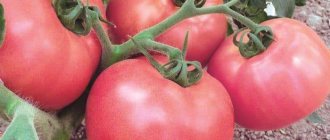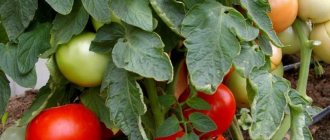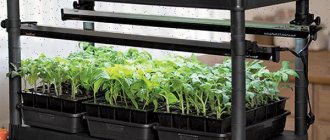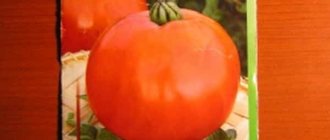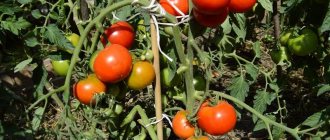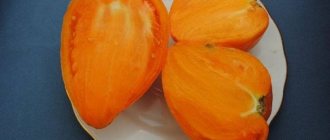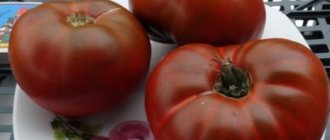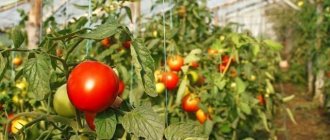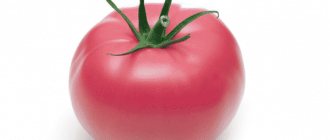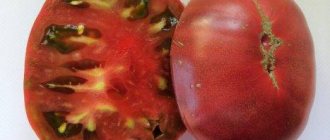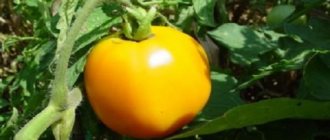Vegetable growing » Tomatoes
0
1300
Article rating
Kira Stoletova
The Rio Fuego tomato has excellent taste and aroma. The thick skin on the fruit protects it from impacts, so it is not afraid of transportation, and is also universally suitable for pickles. Suitable for mechanical cleaning, which explains its high popularity.
Characteristics of tomato variety Rio Fuego
Plant nutrition
An important stage when growing tomatoes.
Tomatoes are more demanding of fertilizers than other crops, so it is important to feed the soil and green mass in a timely manner. Mineral and organic fertilizers are used to feed tomatoes.
First, fertilizing is applied to the seedlings up to 4 times. Then after transplanting the plants to a permanent place of growth. Feeding stages:
The first procedure is carried out two weeks after transplanting the seedlings. The second - in 2 weeks. The third is during the formation of fruits on the bush. The fourth is when the fruits ripen.
For these purposes, organic fertilizers are used in the form of chicken manure, compost, and slurry from cow dung.
Among mineral fertilizers, nitrogen-potassium and phosphorus fertilizers are suitable for feeding tomatoes. Complex fertilizing has a better effect on plant growth and fruit development.
Description
This plant and its fruits have a typical tomato appearance.
Bushes
The bushes are medium in size, the foliage is green. When tied, the height of the bush is 60-70 cm. During the season, several brushes are formed, which are grouped into separate trunks.
Determinate varieties are: Chelnok, Sanka, Klusha, Lyana, Labrador, Chocolate, Star of Siberia, Raspberry Giant.
Fruit
The fruits have a plum-shaped round shape, the weight of one tomato is 100-110 g. They are distinguished by their density, due to which they are well transported. Tomato ripening occurs in stages. Tomatoes have a bright red color, their diameter can reach 7 cm. The structure is quite fleshy and dense.
Seedling
- Seedlings are allowed to be grown independently on a windowsill or in a greenhouse. Young plants are covered with agril and similar non-woven materials.
- Buttocks are not afraid of transplantation. In the phase of four leaves they are dived.
- It is not forbidden to throw agril directly on the plants (in this case, the plants themselves serve as a frame), however, a tunnel shelter is still better, since the tops of the plants are located further away from the film, which prevents them from being damaged by frost.
The beneficial properties of the Rio fuego tomato help in the fight against aging and diseases, and the unique composition of this crop, rich in vitamins, makes it one of the important food products. In addition, low-growing tomatoes are easy to grow, much like unpretentious plants. The advantage of the variety is good transportability, resistance to blossom end rot and late blight.
Harvesting
Harvesting can be done as early as 110 days after the appearance of the first shoots. Tomatoes can be stored for quite a long time, which allows them to be transported to different cities. This variety can be harvested mechanically - the fruits will not suffer from this.
The Rio Fuego variety is not only a beautiful-looking plant, but also a vegetable with a pleasant taste. It is easy to grow, so with a minimum of effort, you can enjoy large, tasty tomatoes for a long time.
Read also: How to feed geraniums for abundant flowering at home How to feed geraniums in autumn, winter and summer
Features of cultivation
For planting activities, it is necessary to prepare a container. For this you can use plastic or wooden containers. Before sowing, disinfect the box and make drainage holes. If this is not done, the plant may be affected by blackleg.
Planting seedlings
To successfully grow seedlings, ensure adequate lighting, temperature conditions and air ventilation.
As for the substrate, a universal mixture purchased in a store or prepared independently is suitable for the Rio Fuego tomato. If the second option is chosen, it is necessary to combine sand and peat in equal proportions. There is no need to sow the seeds too thickly, as the seedlings will stretch out and become thin and weak.
Procedure:
- Before sowing, water the soil thoroughly.
- Pre-soak the seeds in a 1% solution of potassium permanganate to disinfect them. Keep them there for 39 minutes. After this, rinse them under running water.
- Sow the grains in the ground, lightly cover with soil and cover with film to maintain soil moisture.
- Keep seedlings at a temperature of 23 degrees. and as soon as the first shoots appear, remove the film every day for 20-30 minutes.
- With the appearance of 2 leaves on the seedlings, carry out a pick, planting the plants in separate containers.
Planting seedlings in open ground
Procedure:
- Site preparation. It needs to be done in the fall. If the acidity of the soil is increased, then during the autumn digging, add 0.9 kg of lime, 5-7 kg of organic matter, 40-60 g of superphosphate per 1 m2.
- Plant tomato seedlings in the first half of June, when the danger of frost has passed.
- Plant plants in rows, maintaining a distance of 30-40 cm between them, and 30-50 cm between rows.
- Sprinkle with soil and place a layer of mulch on top to maintain moisture. Peat or sawdust is suitable for these purposes.
Features of care
Caring for the Rio Fuego variety is easy if you adhere to the following recommendations:
- Loosening. Between the rows the soil needs to be loosened. Do this every 10-12 days, but at least once throughout the summer. If cultivation occurs on heavy soil, then deep loosen in the first 2 weeks after planting the seedlings.
- Hilling. Hill up tomatoes for the first time 9-11 days after planting. Water before starting, as hilling up wet soil will speed up the formation of new roots on the stem of the crop. The second time the manipulation is carried out 16-20 days after the first.
- Watering. The Rio Fuego tomato needs regular moisture. Water directly into the holes. One plant requires 0.7-0.9 liters of water. It is best to moisten the soil in the evening. Watering is especially important during the flowering of the first and second clusters, before loosening the soil and applying fertilizers.
- Air humidity. The variety is not particularly demanding on humidity, but when it is too high, it is fraught with late blight and brown spot.
- Feeding. Throughout the summer, regularly feed tomatoes using mineral and organic compounds.
Description of the variety
Rio Fuego is a variety of tomato whose fruit has excellent taste and aroma. The consistency is dense and meaty, making the harvested crop perfect for processing and producing tomato paste. The thick skin retains the taste and perfectly holds the shape of the tomato when used in brine and marinade. In addition, the appearance of vegetables does not deteriorate during transportation. If unripe tomatoes are removed from the root, they must be kept in a cold place for a month, after which they will become ripe and tasty.
The advantages of the variety include:
- good productivity, since from 1 m2 it is possible to obtain 10-12 kg of ripe vegetables;
- persistent immunity, thanks to which the variety is not afraid of such diseases as Alternaria, Verticillium and Fusarium wilt;
- has excellent taste and can be used for processing and fresh consumption;
- characterized by excellent transportability.
As for the disadvantages, the Rio Fuego variety has virtually none. Some gardeners complain that tomatoes lack juiciness, but this disadvantage is easily compensated for by the amazing taste and aroma of vegetables.
Photo
To better study the Rio Fuego variety, you can view the photographs below.
You can also watch a video where an experienced gardener will tell you how a tomato grew in open ground.
The Rio Fuego tomato is a popular tomato variety that is suitable for growing outdoors. It is rarely affected by diseases and pests, it is easy to grow, and the harvested crop pleases with a pleasant aroma and excellent taste.
Tomato Igranda - description and characteristics of the variety
The world of tomatoes is replete with a variety of species and varieties. All varieties have their own distinct characteristics. The Igranda variety was bred by German breeders and has already gained immense popularity in our country. Gardeners fell in love with this variety for its high yield. Low-growing bushes do not always need staking; they are suitable for growing in greenhouse conditions and in garden beds. Tomatoes are widely used for fresh consumption, in salads with other vegetables and for various preparations. No complete diet is complete without the participation of tomatoes.
Diseases
While growing tomatoes, vegetable growers may encounter various painful conditions: curled and yellowed leaves, drooping stems, blackened fruits. Tomato diseases are provoked by:
- viruses;
- bacteria;
- various mushrooms;
- improper care or growing conditions;
- lack of microelements.
Late blight is one of the most dangerous and common fungal diseases of tomatoes. This painful condition most often affects varieties of late ripeness, so Rio Fuego suffers from it very rarely.
Gray rot can damage tomatoes when the humidity and plant density are high. First, gray-brown spots appear on the leaves, then the stems and fruits are damaged. If the plant is not treated in time, it may die.
The characteristics of Rio Fuego indicate that it is resistant to attacks by Alternaria, Verticillium, and Fusar wilt.
Prevention
To prevent phytosporosis, plants need to be treated with fungicidal preparations (Fitosporin-M, Tatu, Ridomil Gold). A 10% solution of table salt (100 g of salt per 10 liters of water) is also suitable for processing. In addition, the following rules must be observed:
- plant tomatoes near other nightshades, for example potatoes, which are carriers of the disease;
- dig the soil deeply;
- remove affected leaves and plants;
- water the tomatoes at the root;
- use folk remedies (garlic tincture).
When the first signs of gray rot appear, plants should be treated with fungicides (Switch, Fundazol). To prevent the development of the disease, the following measures are taken:
- damaged areas on tomatoes should be lubricated with fungicide solutions or chalk;
- Ensure good ventilation of plants - plant them at the required distance from each other.
It is necessary to promptly remove diseased fruits or plants and change crops growing in the same bed. During frosts, tomatoes should be covered with film or agrofibre overnight.
View "Original"
One of the favorite tomatoes in a summer resident’s collection is the proven “Rio Grande”, which was bred by Dutch breeders and has become a true gardening classic not only in Russia, but also abroad.
The variety is presented on the market by seeds called “Rio Grande Original”.
This is a universal mid-early variety, intended for cultivation both in a greenhouse and in open ground. Resistant to difficult climatic growing conditions.
Rio Grande tomatoes have characteristic features that distinguish them from other varieties:
Description of the tomato variety Koenigsberg and its subspecies
| Average fruit weight | up to 150 gr. |
| Maturation speed | 120 days |
| Bush height | 0.5–1 meter. |
| color | red |
| Taste | sweet |
| Precocity | 120 days |
| Average yield per bush | 4 kg. |
| Maturation period | June-September |
This is a powerful determinate, medium-sized plant, approximately 50–100 centimeters high, which does not require the gardener to tie up or prun the bushes. Weakly affected by late blight.
Tomato fruits are red, oblong, ovoid, weighing 70–150 grams, small-chambered, have a strong, thick skin, and are resistant to heat. Thanks to these qualities, they have ideal density and shape for transporting and storing crops.
Used mainly for culinary processing and preparations:
- Drying and curing (in the sun or in a vegetable dryer);
- Processing into tomato paste, adjika, tomato juice;
- Whole canning and pickling;
- Baking and grilling;
- Freezing in the freezer.
“Rio Grande Original” is valued by gardeners for its consistent and high yield and excellent taste.
Advantages of the variety:
- High yield guarantee;
- Excellent taste;
- No pinching or gartering required;
- Easy to care for;
- Long period of productivity;
- Versatility of use;
- Able to withstand long-term transportation, loading, unloading and delivery to the destination;
- Resistance to difficult climatic conditions.
Rio Grande tomatoes - an unpretentious variety for beginning gardeners
Hello, dear readers! If you are a fan of cream tomatoes, then you will surely appreciate the Rio Grande tomato. It is recommended to start getting acquainted with the culture as such, because it is unpretentious, resistant to dry, hot weather, and does not require any special manipulations, but everything is in order.
Characteristics and Features
Speaking about the characteristics and description of the variety, it is worth noting that this is a medium-sized, determinate, productive variety with an average period of fruit ripening: 110–120 days pass from the appearance of the first greenery to the harvesting of the first formed fruits.
Being the result of selection by Dutch specialists, the Rio Grande tomato variety does not require pinching or tying, so it does not cause much trouble for gardeners. The bushes grow 60–70 cm in height, forming 8–10 ovaries with characteristic oblong fruits of medium size weighing 100–115 g.
Ask and receive useful advice from professional gardeners and experienced summer residents.>>
Their peculiarity is a sweetish taste with a slight sourness, a smooth, glossy surface, a dense, thick peel and a small number of seeds. Judging by the reviews, this variety of tomatoes is most often chosen for canning, pickling or pickling. At the same time, there are other varieties of Rio tomatoes:
- Tomato Trans Rio. If you believe the description, it also produces pear-shaped fruits, but they ripen earlier - after 95–100 days. Gives a high, stable yield provided the fruits ripen smoothly.
- Rio Fuego. This tomato is also very similar to its brother - the Rio Grande tomato variety, but it is characterized by a friendly yield, while the Grande has a longer fruiting period. Fuego looks and tastes very similar to grande.
Advantages and disadvantages of the variety
Of course, like any other, this tomato variety has its advantages and disadvantages. These include:
- Thick skin. This feature prevents cracking of the fruits and thereby prolongs their shelf life and increases the ability to be transported, especially over long distances. This property of Rio Grande tomatoes will be appreciated by both ordinary lovers and farmers who grow them for sale.
- Increased dry matter content.
- Possibility to ripen after harvesting in green form.
- An unpretentious tomato, resistant to growing conditions and climate.
- Very productive, friendly shoots.
- Rio Grande original tomatoes have only one drawback - the fleshy fruits are characterized by low juiciness.
How to grow?
Actually, growing Rio Grande tomatoes is no different from growing other varieties of tomatoes. Care recommendations depend on whether you will be cultivating them in a greenhouse or outdoors. Fruits are easy to grow both there and there, if you comply with all the necessary conditions - regularly water, loosen the soil, apply mulch and fertilizers.
Description of the tomato variety Rio Fuego and its characteristics
The tomato variety "Rio Fuego" is a mid-early, productive, determinate tomato. Bred in Holland and recommended for cultivation in open ground and in various types of film shelters.
The characteristics and description of the tomato variety “Rio Fuego” states that the period from sowing the seeds into the soil until the ripening of the first fruits is 110-115 days. The stem of the “Rio Fuego” bush is powerful, stable, the leaves are dark green in color and have a regular shape.
This variety does not require tying to a support or pinching, but it is recommended to make supports to avoid contact of the fruit with the soil. The first ovary appears after 4 leaves.
During the season it can produce about 10 bunches of tomatoes. Each cluster has 4-6 fruits of the same size and shape.
Fruit characteristics
The fruits of the Rio Fuego tomato are plum-shaped, round, bright red, without greenery at the stalk, very dense, sugary. Inside there are 2-3 chambers with a small number of small seeds. They are easily torn from a bush without a stalk, which allows them to be collected by machine. The weight of one fruit of these tomatoes, depending on growing and care conditions, ranges from 100 to 140 grams. The average length of one fruit is 5-7 cm.
Taste and technical characteristics
The Rio Fuego variety has good taste and aroma. The dense, fleshy consistency allows you to obtain high-quality tomato paste during factory processing. The thick skin retains a pleasant taste and firmly holds the shape of the tomato in brine and marinades, in slices and homemade salads.
Standard tomatoes look very nice in jars. The Rio Fuego tomato has also earned rave reviews from housewives for its sugary pulp.
Sauces, purees and ketchups made from these tomatoes are tasty and beautiful. "Rio Fuego" is easily transported and stored. After being removed from the root, unripe tomatoes can be stored for up to 1 month in a cool place or in the refrigerator.
Features of cultivation
“Rio Fuego” tomatoes were specially adapted by the developers of this variety for growing in open ground. An unpretentious, cold-resistant tomato, suitable for industrial cultivation in vegetable farms. The yield of this tomato variety is about 10 kg per 1m2.
Direct sowing of tomatoes of this variety in the ground is also recommended, however, the growing season of the plant is lengthened and under such conditions it is impossible to obtain an early harvest. Sow "Rio Fuego" seeds 6-8 weeks after the last expected frost date in the region. Sowing is carried out in illuminated warm rooms, heated greenhouses or greenhouses. Optimal germination of sprouts occurs after 7 days at constant humidity and soil temperature of 60-70%.
An important point for obtaining healthy and fertile tomato seedlings is the optimal combination of humidity and temperature. Watering is carried out every 10-12 days, but more often is possible. The soil temperature when watering should not be higher than 24 degrees, and the optimal water temperature is 20 degrees.
Planting of ready-made tomato seedlings is carried out according to the 50 x 40 cm scheme, 3-4 plant bushes per 1 m2. It is possible to plant up to 6 bushes per 1m2.
To obtain abundant harvests, the correct selection of a site for planting is also necessary. It must be remembered that the “Rio Fuego” tomato variety is not effectively planted in the ground after vegetable crops such as onions, potatoes, cabbage, and eggplants.
Proper and timely application of fertilizers, mulching and loosening the soil on the plot of land chosen for planting is an integral part and the key to the profit of the farm.
Disease resistance
| № | Type of disease | Degree of stability |
| 1 | Verticillium wilt (V-1) | high |
| 2 | Fusarium wilt (races 1,2) | high |
| 3 | Alternaria stem cancer | high |
| 4 | Bacterial fruit spot (BSK-0 (IR) | high |
| 5 | Tomato nematode | high |
Characteristics of Trans Rio tomato and variety cultivation technique
The Trans Rio tomato, the description of which is associated with the exotic shape of the fruit and excellent taste, is recommended to be grown in open areas. The tomato is popular among vegetable growers due to its ease of care and resistance to the main types of diseases of nightshade crops.
Advantages of the variety
The early-ripening tomato variety Trans Rio is intended for cultivation in open and protected ground. The plant begins to bear fruit 92-97 days after emergence.
A compact bush of determinate type, depending on growing conditions during the growing season, reaches a height of 40-120 cm. A plant planted in open ground does not require tying to a support and removing shoots.
The stem may become deformed under the weight of ripening fruits, so experts recommend tying up the crop.
The characteristics of the variety are associated with the description of plum-pear-shaped tomatoes. Tomatoes without a spot near the stalk, at the stage of technical ripeness, acquire an intense red color. Tomatoes with dense pulp, medium juiciness, sweet taste with a barely noticeable sour note.
The weight of the tomato reaches 80-100 g. The Trans Rio variety is characterized by stable yields and smooth ripening. If you follow the rules of agricultural technology, you can remove 15 kg of fruit from 1 m². The Trans Rio variety is recommended to be grown on an industrial scale.
Reviews from vegetable growers indicate that the plant is highly resistant to a range of diseases characteristic of nightshade crops. The collected fruits tolerate transportation well over distances and can be stored for a long time.
Agricultural technology for tomato cultivation
When grown indoors, seeds are sown for seedlings in March. To do this, pour the prepared soil mixture or substrate into special containers, compact it lightly and make grooves 1 cm deep.
Before sowing, the seeds are treated with an aqueous solution of aloe juice and a growth stimulator. This event ensures the friendly emergence of sprouts and the formation of healthy seedlings.
After planting the seeds, water with warm water using a sprayer, cover the container with glass until loops appear. At the stage of formation of real leaves, picking is carried out.
For this purpose, peat pots with a diameter of 8 cm are used, with which it is convenient to transfer plants into the ground. Their use helps prevent damage to the root system and helps the plant adapt more easily to a new location.
When growing seedlings, it is important to maintain temperature conditions. It is recommended to harden off the seedlings before planting in the ground.
To do this, the seedlings are taken outside for 7-10 days, gradually increasing the exposure time from 30 minutes to several hours.
When growing seedlings in an apartment for hardening, you can open the window or take containers with planting material to the balcony. The seedlings are transferred to the ground after the end of the spring frost period, when the soil warms up to +16°C.
Planting of crops is carried out taking into account crop rotation. The best predecessors for tomatoes are cucumbers, zucchini, carrots, and parsley. Compost is added to the prepared holes.
Caring for the crop involves regularly removing shoots when 4-6 inflorescences appear. Tomato variety Trans Rio requires moderate watering. To ensure moisture levels, it is recommended to mulch the soil with fiber or organic materials.
When cultivating the variety in protected soil conditions, drip irrigation is used. Tomato care involves weeding, loosening the soil, and timely harvesting.
Tomatoes respond well to fertilizing with complex fertilizers containing phosphorus, potassium, and nitrogen. Their use has a better effect on crop growth and fruit formation. The composition of fertilizers depends on the type of soil and the stage of plant development.
Growing tomatoes
Planting occurs in seedlings. To sow, you need to purchase seeds. To make the sprouts sprout faster, it is recommended to put them in wet gauze or a napkin for a day. To sow, you need to prepare the soil. If you decide to use a ready-made substrate, then all the necessary additives are already there. Garden soil requires preliminary preparation. This will help protect future plants from fungi and pests. The prepared soil should be placed in a hot oven for 3 hours. This will kill all possible harmful insects and dangerous fungi. After this, the soil should be poured into boxes or containers.
The seeds are sown to a depth of no more than 2 cm. The top of the boxes must be covered with film or glass. The boxes should be kept in the sun and warm.
tomato Ivanych F1 - description and characteristics of the variety
View "Original"
One of the favorite tomatoes in a summer resident’s collection is the proven “Rio Grande”, which was bred by Dutch breeders and has become a true gardening classic not only in Russia, but also abroad.
The variety is presented on the market by seeds called “Rio Grande Original”.
This is a universal mid-early variety, intended for cultivation both in a greenhouse and in open ground. Resistant to difficult climatic growing conditions.
Rio Grande tomatoes have characteristic features that distinguish them from other varieties:
This is a powerful determinate, medium-sized plant, approximately 50–100 centimeters high, which does not require the gardener to tie up or prun the bushes. Weakly affected by late blight.
Tomato fruits are red, oblong, ovoid, weighing 70–150 grams, small-chambered, have a strong, thick skin, and are resistant to heat. Thanks to these qualities, they have ideal density and shape for transporting and storing crops.
Used mainly for culinary processing and preparations:
- Drying and curing (in the sun or in a vegetable dryer),
- Processing into tomato paste, adjika, tomato juice,
- Canning and pickling whole,
- Baking and grilling,
- Freezing in the freezer.
“Rio Grande Original” is valued by gardeners for its consistent and high yield and excellent taste.
- High yield guarantee,
- Excellent taste,
- No pinching or garter required,
- Easy to care for
- Long period of productivity,
- Versatility of use,
- Able to withstand long-term transportation, loading, unloading and delivery to the destination,
- Resistance to difficult climatic conditions.
Determinate early ripening variety for open and protected ground. One of the best options for outdoor growing.
Plant growth ends after the formation of inflorescences with the formation of a small compact bush with a moderate number of leaves. The ripening period of the fruit is 95–100 days.
Ripe fruits have an elongated plum-pear shape and a rich red color.
Description and characteristics of the variety “trans Rio”:
- The bushes reach a height of 1 meter, compact, do not require pinching, with a moderate amount of foliage,
- Growing season – 95–100 days, after full germination,
- Tomato weight 80–100 grams,
- The fruits are dense, bright red or pink, the skin is thin, glossy,
- Able to withstand long-term transportation, loading, unloading and delivery to the destination,
- Friendly ripening and high yield.
A low-growing plant with a determinate structure, it belongs to the group of early-ripening tomato varieties intended for planting in open ground in seedlings and without seedlings.
Characteristics and description:
- Requires minimal attention
- Resistant to a wide range of diseases, including late blight,
- Ripening time – 110–115 days after sowing,
- Fruits of an elongated oblong shape in the form of a plum, with a dense fleshy structure, weighing 110–115 grams,
- The tomato is highly prolific: several clusters with a large number of fruits are formed on the bush.
The most productive tomato seeds of Siberian selection
Siberia is a rather peculiar and somewhat “cruel” region in relation to fruit-bearing crops. Here you should be careful when choosing seeds, since the slightest mistakes will leave you completely without a harvest and without salting for the winter.
It should also be noted that Siberian selection is one of the most popular seeds, because their frost resistance and other positive characteristics make it possible to use them for planting in any region of Russia.
In addition, varieties belonging to Siberian selection have a huge selection, also divided into groups depending on the growth of bushes and fruitfulness, time of planting and characteristics of independent cultivation. Thus, today the following collections of Siberian selection are distinguished:
- "Seeds of Altai";
- "Siberian Garden";
- "Siberiada".
Each collection has up to several dozen varieties, the fruits of which differ in size, weight, color and other characteristics. The characteristics and description of the variety influence both the choice and the result.
Early varieties of tomatoes
Of course, early varieties of tomatoes are popular in the Siberian region, including:
1. “Ultra-early ripening” - the variety is to the taste of housewives, since the small size fruits of these seeds are ideal for canning. The average weight of one tomato is only 100 g, and the harvest can be expected within a month and a half after the first seedlings enter.
The bush itself reaches a maximum height of 50 cm, so it is suitable for planting both in a small greenhouse and in open ground. These seeds belong to the Siberian Garden collection.
2. “Demidov” - the small height of the bush (only 50 cm) and the weight of one tomato of 200 g makes these seeds popular in cultivation for the further use of fruits in the preparation of salads. Has a slightly sweet taste.
Growing tomatoes
Change the planting location of the bushes annually
This variety can be grown immediately in open ground.
It is important to choose a suitable place in the garden: it should be sunny, without drafts, well protected from the wind. The predecessors of tomatoes can be cucumbers, legumes, cabbage
It is unacceptable to grow plants for several years in a row in the same place, since the larvae of pests of nightshade crops remain in the ground.
Planting seeds
Before planting seeds, it is necessary to prepare the soil.
Soil preparation rules:
- Dig a bed no more than 1.2 m wide (the optimal time is the end of April).
- For every sq. m. add no more than half a bucket of humus and 0.5 liters of ash.
- Draw two grooves in the garden bed up to 10 cm deep, their distance from each other is about half a meter.
- The soil in the furrows should be disinfected with a weak solution of potassium permanganate.
- The bed needs to be wrapped in film for a week to warm it up.
After seven days, the bed is ready for sowing tomatoes, after which the film must be removed, indentations should be made in each groove at a distance of 35-55 cm and tomato seeds should be sown (1-2 pcs.). The seeds should be sprinkled with soil, preferably peat or sand.
Sowing is carried out in late April - early May, the ground is covered with a film, its edges are tightly covered with earth, as a result of which the sprouts will be reliably protected from the night cold.
Sprout care
The first shoots appear after a week, when they reach the cover, it should be raised with the help of supports, the soil around the plants is loosened. R
Advantages of sowing seeds in open ground:
- the seedless method forms a strong root system and excellent immunity in the sprouts: such tomatoes are not afraid of either drought or painful conditions;
- plants do not experience stress when picking and replanting, so they bloom and bear fruit early;
- caring for plants is much easier than when growing seedlings, and the result is much better.
In hot weather, the film must be lifted and ventilated. Tomatoes are hardened in this way and are not afraid of temperature changes.
Fertilizer
The first fertilizing should be carried out 3 weeks after sowing the seeds. It is not recommended to feed the sprouts before the first full leaf appears, since oversaturation with some substances can lead to a negative result. For the first feeding, it is recommended to use the following solution: 1 tbsp. a spoonful of fertilizer (“Nitrophoska”, “Agricol No. 3”) is diluted in 1 liter of water. The resulting solution is enough to fertilize about 35 plants.
After 14 days, fertilizers are applied a second time: if the tomato has a thin stem, a superphosphate solution should be used (1 tablespoon of fertilizer is diluted in 3 liters of water). You can use the drug “Athlet” for feeding once. To fertilize healthy plants that meet all necessary requirements, use “Effecton O”.
In the future, tomatoes are fertilized every 20 days. Throughout the entire growing season of the plant, fertilizing is carried out up to 5 times, taking into account the fertility of the soil.
Watering
Abundant watering is required until the third cluster of flowers appears.
Sprouts under the film are not watered, since in spring there is enough moisture in the soil, but if spring is very early and warm, then the plants are carefully watered at the root with warm water in the morning or evening. Plants should be watered abundantly until the third cluster with flowers appears, otherwise the tomato will mobilize all its forces for the development of the root system
As a result, fruit growth will slow down and precious time will be lost, which can result in a significant reduction in yield.
Plants should be watered abundantly until the third cluster with flowers appears, otherwise the tomato will mobilize all its forces to develop the root system. As a result, fruit growth will slow down and precious time will be lost, which can result in a significant reduction in yield.
Description
This plant and its fruits have a typical tomato appearance.
The bushes are medium in size, the foliage is green. When tied, the height of the bush is 60-70 cm. During the season, several brushes are formed, which are grouped into separate trunks.
The fruits have a plum-shaped round shape, the weight of one tomato is 100-110 g. They are distinguished by their density, due to which they are well transported. Tomato ripening occurs in stages. Tomatoes have a bright red color, their diameter can reach 7 cm. The structure is quite fleshy and dense.
Some information about the variety
Fuego type tomatoes have the following characteristics:
- The vegetation cycle of this plant from the first shoots to mature fruits lasts 110-115 days.
- The Rio Fuego tomato bush has a powerful stem. It is covered with green leaves by 30-40%.
- The height of the bushes of this variety is 0.6-0.7 m. It is recommended to tie them to low supports, otherwise the plant will begin to grow in width.
- The first ovary develops after the appearance of 4 leaves.
- A tomato of this variety can bear up to 8-10 clusters per season, and on each cluster 4 to 6 fruits of equal size are formed.
The Rio Fuego tomato has the following fruit description:
- This tomato variety resembles a plum in shape. It is elongated, and its average length is from 50 to 70 mm. The fruit is painted bright red. It is quite dense to the touch, quite sugary.
- Inside the tomato there are 2 or 3 chambers containing a small number of seeds.
Reviews from gardeners show that the fruits are easy to remove from the bush, since the stalk remains on the plant. Therefore, on large farms it is possible to carry out machine harvesting. The average weight of tomato fruits of this variety ranges from 0.1 to 0.14 kg. The productivity of the variety is quite high. It is 9-10 kg of fruits per 1 m². The thick skin holds the shape of the tomato well when used in brine or marinade.
Photos of this plant can be seen in catalogs of companies selling tomato seeds. Fruits of the described type are well stored and can be transported over long distances. Therefore, it is grown on an industrial scale for processing into tomato paste, ketchup and juices.
Landing
Rio Fuego can be planted in seedlings or without seedlings. When sowing seeds directly into a greenhouse or open ground, it is necessary that the ground warms up by 20°C.
Seeds for seedlings are sown traditionally: for a greenhouse - in early March, for open ground - in early April. The plants are replanted after two months.
Sowing
Seeds must be disinfected with a manganese solution and germinate in a damp cloth. When sown in a garden bed, they are laid out in furrows at a distance of 40-50 cm, moistened, sprinkled with earth and covered with film.
Plants need to be fertilized regularly
In a tray, seeds are sown at a distance of 2 cm from each other, deepening by 1 cm. Temperature for germination is 23-25°C.
Seedling
Shoots appear in about a week. The film is removed from the crops and the first watering is done with warm water. Next, the seedlings are watered once every 10 days. At the stage of 2-3 true leaves, the plants are dived from the tray into separate containers, while adding mineral fertilizers.
A week before transplantation, they begin to harden them - they are taken outside every day or the windows are opened.
Transfer
The soil in the garden bed is treated with manganese and loosened. Install pegs for support. Planting holes are placed at a distance of 40-50 cm (if there is a shortage of space, you can plant bushes every 30 cm and then form them into 1-2 stems).
Ash, crushed eggshells, compost, and mineral fertilizers are placed in the holes. The bushes are watered generously with warm water.
The bushes are formed into several stems, removing excess shoots and lower leaves. Despite the average growth of tomatoes, it is better to tie the stems so that the fruits do not fall to the ground (touching the soil, they can rot or be affected by pests).
Planting and propagation
You can grow Rio Grande in two classic ways: through seedlings or directly from seeds. There is essentially no difference: if you plant seeds, you will spend less time, but you will wait longer for the harvest, but with seedlings the opposite is true - more time for preparation, but the harvest will be earlier.
The time for planting is selected individually - the main thing is that there are no severe frosts by this time. Focus on the air temperature - it should not drop below +12 even at night.
It is better to fertilize the soil with organic matter a few days before planting: humus, manure, compost.
An important point is that the soil needs to be treated with any antiseptic - this is mandatory, otherwise the plants are likely to grow sick.
Plant Rio Grande in shallow holes - literally a few centimeters - so it will be easy for them to emerge. Sprinkle soil on top; there is no need to compact it.
You shouldn’t water it right away either—moisten the soil with a spray bottle. The water should be slightly warmed, but not hot.
Read also: Advantages of using “Boa constrictor” hives
As mentioned above, these tomatoes are unpretentious and quite easy to care for.
- Watering - do not be too frequent with it. Lightly water the Rio Grande several times a week and be guided by the soil around it - if it is very dry, add water, if it is wet, remove the watering. Water pours under the root of the bush.
- The bushes need to be weeded periodically - usually 4-5 times in one season is enough, no more is necessary;
- A couple of weeks after planting, the tomatoes should be “fed” with any fertilizer containing phosphorus. And during the flowering period - with potassium.
Growing and care
Growing and caring for low-growing tomatoes is not difficult; the bushes do not necessarily need to be tied and pinched. It is recommended to remove the lower leaves that are in contact with the ground.
When planting in open ground, it is necessary to constantly ensure that the distance between plants is not less than 40 cm. Bushes can be planted in official ground at the end of May, when the last frost has passed, otherwise the plants may bend. When planting in holes, it is necessary to add organic fertilizers and pour plenty of water. As a rule, tomatoes are not planted for seedlings until two months before planting in open ground, so that the seedlings are as strong as possible. For growing this crop, sandy and loamy soil is ideal. When growing seedlings, it is advisable to carry out seed prevention. To achieve this, they need to be placed in a non-concentrated solution of potassium permanganate. The best predecessors of tomatoes: cucumbers; safa; zucchini; onion. When planting, it simply does not make sense to deepen the seeds deeper than two centimeters, because this will slow down the development of the tomato. Although this variety is resistant to diseases, it still requires prevention. Treatment with the biological product phytosporin is indicated. During the first planting life, the plant needs the most active watering. If you are growing seedlings yourself, please note that sowing seeds should be done 65 days before the expected time of planting. To accelerate the development of roots, after the first shoots have appeared, a small amount of soil is added to them. After planting, it is advisable to carry out the procedure of mulching the soil with straw
To obtain the maximum yield, it is necessary to carry out such procedures as: loosening, abundant and timely watering, fertilizing and weeding. An important component of caring for this variety is, as already mentioned earlier, the pinching procedure, which involves removing shoots in the hope of directing all the energy into the fruits and not the bush.
Watering the bushes is worth the effort directly at the root with warm water, otherwise there is a risk of sunburn on the foliage and fruits.
Determinate variety for open ground Rio Fuego
Tomato is one of the most common vegetables that all summer residents grow. The huge variety of varieties sometimes makes it difficult to choose seeds.
In our article we will tell you what the Rio Fuego tomato is and give characteristics and descriptions of this variety.
- Variety selection
- Description
- Characteristics of the variety
- Advantages and disadvantages
- Landing Features
- How to care for tomatoes
- Pests and diseases
- Harvesting
Variety selection
"Rio Fuego" is a determinant species; it was bred by Dutch breeders.
Important! Planting tomatoes in an area where potatoes were previously grown is strictly prohibited!
Over time, “Rio Fuego” gained popularity in other countries - Ukraine, Moldova, Russia.
Advantages and disadvantages
Like any variety, “Rio Fuego” has its advantages and disadvantages.
The benefits include:
- good yield - from 1 sq. meter you can collect 10-12 kg of tomatoes;
- not susceptible to attacks by Alternaria, Verticillium and Fusarium wilt;
- has excellent taste, ideal for canning and salads;
- has excellent transportability.
Rio Fuego has virtually no flaws. Some gardeners complain that the tomato does not have good juiciness, but this disadvantage is compensated by the amazing taste and aroma of the fruit.
Landing Features
When choosing a place for planting, it is better to give preference to those areas where cucumbers and zucchini were previously grown. Good precursors for tomatoes are: dill, carrots, parsley, cauliflower.
When planting tomatoes without seedlings, you should adhere to the optimal planting pattern - 50x60 cm. It is worth deepening the seed material into the soil by about 1-1.5 cm. Planting can be done only when the soil warms up to 20°C.
Important! Plants can be treated with insecticides only before the flowering period begins!
How to care for tomatoes
Watering the planted seed material must be done with warm water. After irrigation, the area should be covered with film. It is recommended to fertilize 2-3 times per season using phosphorus-containing complexes or diluted bird droppings. To give the bushes an attractive appearance, as well as improve productivity, it is worth tying up the bushes.
Pests and diseases
As mentioned above, the variety has good resistance to diseases and pests. However, for preventive purposes, in order to prevent the development of fungi, it is worth spraying the plants with phytosporin. Mulching will also be useful.
Pest control is carried out using insecticides. In the fight against naked slugs, it is worth spraying the bushes with ammonia solution. Aphids must be removed with soapy water.
Did you know? Until the 17th century, tomatoes in Europe were considered inedible and were used only as ornamental plants. It wasn't until 1692 that the first recipe that included tomatoes appeared in Naples.
Rio Grande - unusual tomatoes, originally from Holland
For twenty years now I have been growing various vegetables and fruits at my dacha. After that, I sell them - this amount of products alone is enough for me with a large surplus, and both in business and with money. In order for people to buy products, I constantly try to expand, plant something new, and try.
But there are varieties in my garden that have been tested for decades. These are old, but high-quality varieties, they are well studied and therefore do not bring any surprises.
Read also: What are the benefits of thorns for human health: uses and contraindications
One of them is Rio Grande tomatoes, bred by Dutch specialists several decades ago. They are already very easy to care for, and for so many years summer residents have literally studied them completely.
In this article I will tell you how to grow Rio Grande in any area, reveal several nuances and generally describe this variety. I’ll say right away that it’s simply excellent and is very popular among my customers - large, tasty tomatoes, they fit perfectly and are versatile in cooking.
They are good both for growing for home use and for sale - the bushes produce good harvests, and the fruits themselves are also stored well.
